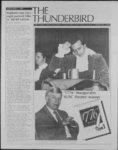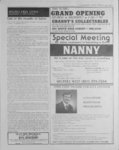| OCR Text |
Show THE THUNDERBIRD MONDAY NOVFMBER 2. 1987 PACE 3 Loans arrive after five week wait BY DANNY STEWART After five weeks of waiting, SUSC students are last in the state to receive promissory notes for student loans. A main cause for the delay was SUSC's failure to send correct proofs of the notes to a Salt Lake company for printing, according to Eric Schmutz, manager of loan collections. "The notes were delayed for a number of reasons," said Schmutz. He added that SUSC began designing proofs for the promissory notes before fall classes began, but they had to be revised several times because of mistakes. Dixie College students also had to wait for promissory notes. "There was a delay with the notes, it took about two weeks for us to receive them from the printer, but students have their money now," said Dixie's financial aid officers. All other Utah institutions had to print temporary promissory notes, but students received them on the first day of classes. Financial Aid officials from the College of Eastern Utah said, "Because of changes in regulations we had to get our own notes made, but our students had no problem getting their money. Officials from Salt Lake Community College said they've been hand-typin- g the notes according to regulation until last week when computer copies came through. "The only students who didn't receive loans are those who didn't qualify," they said. The story was similar at the University of Utah. "W'e made our own notes, with a few adaptations, but it didn't affect the students. For them, everything went as scheduled. It's really gone fairly smoothly," they said. Utah State University also completed its own forms. "It could have been a problem, but we printed the notes manually and had everything taken care of early," said USU officials. At Weber State University, financial aid officers utilized campus typesetting equipment to prepare the notes. "We are fortunate to have a typesetter to facilitate the correction of revisions," they said, "The only delay was one Friday when students had to wait two hours or so for forms to be typed up," they said. SUSC also has equipment for' typesetting and printing, but inquiries were not made to have the notes done here. Financial aid officers at Utah Valley Community College also had notes ready for students on the first day of classes. "The only delays, if any, were because students failed to do what was necessary to receive them," officials said Promissory notes arrived at SUSC Friday, and students can contact the financial aid department for information concerning their loans. According to Schmutz, there should be no problem obtaining loans in the future. "If students sign notes at the end of the quarter, checks will be available at the beginning of the next quarter," he said. Tullis relates cocaine trade and its effects to Convocation audience BY ROBBIE REID BYU professor F. LaMond Tullis took the Convocation audience on a tour of the cocaine industry and its effects on the countries that produce it Thursday. Tullis explained that vast amounts of cocaine are imported to the United States from countries such as Bolivia and Peru. "Cocaine is a thriving industry. It's an international commodity," said Tullis. According to Tullis, cocaine comes from a raw agricultural product. Peru and Bolivia grow and process 90 percent of the world's cocaine supply due to the fact that both countries have proper climate and elevations needed for cultivation. Colombia Parking area BY NATALIE is exports 54 percent of the American habit. Tullis also spoke on the relationship between hunger and cocaine trafficking. In Peru and Bolivia, 50 percent of the children suffer from malnutrition. "Research shows that malnutrition is irreversible in infancy, " said the BYU professor. Families with substantially low incomes must depend on staple foods such as potatoes. With this as the case, some farmers grow cocaine to help feed their families and to obtain a higher income. "Trafficking cocaine accounts for industrial trade more than regular trade. It's the heart of the economy," Tullis said. Cocaine originates as a bush in which the leaves contain the cocaine extract. It can be cropped four to expanded CONDIE The five percent enrollment increase this year at SUSC also creates a greater demand for parking on campus. Within four weeks, 40 new parking spaces will be available for faculty and students between the Science Building and South Hall. The new stalls will cost $10,000 and funding will come from the state building board, said Michael D. Richards, vice president for college relations. Currently, drainage work is being done at the site, then sidewalk, curb and gutter work will be done. After that, Ashdown Brothers Construction, the firm contracted for the job, will move in and complete the work on the new lot, said Richards. Although SUSC is 250 spaces short of the Building Board Standards, no more spaces will be added this year. "This is all we could do with this year's resources," said Richards. "Next year, we will submit more requests to the legislature." Other projects planned for SUSC's parking facilities next year include resurfacing the college's existing parking lots. six times a year. The bushes grow at an altitude of 14,000 feet and can be grown on hillsides. The leaves are dried in the sun and then soaked in kerosene. The mixture is made into a paste. After this process, the paste is taken to a lab where it is refined. "Cocaine grown on small plots can render a market stability for a family. Their income can increase by 10-5- 0 percent," said Tullis. Teams have been organized in the past to destroy the cocaine crop, but the efforts have failed and have sometimes resulted in death. Farmers have been asked and paid to grow something else, but this usually fails because cocaine brings in a higher income, Tullis commented. Deans' Council scotches absence policy become BY LISA JANE LAIRD SUSC's Deans' Council moved on Thursday to extend the school year an extra week into June, at least for the next two calendar years. Provost Terry Alger, who chairs the council, said that after consulting the Faculty Senate and ASSUSC leaders, both bodies preferred a longer spring break while keeping the Good Friday holiday, even if it meant extending into June. In other business, K.C. Jones, ASSUSC academic vice president, presented an excused absence proposal to the council. Jones said the proposal was something ASSUSC was researching, and he turned the time over to ASSUSC Senator Micheal Bahr to explain the purpose behind the proposal. Bahr explained that a student would take the form to his instructors before leaving on a school approved activity. The instructor would then sign the form to tell the student what his standing was in the class and what assignments would be missed. Bahr said that if it were a standardized approved, this would procedure for the college. While the Deans' Council said the proposal had merit and would make students accountable for missed work, they recommended that ASSUSC look at a few other options. Al Tait, dean of science, said, vlt may actually bring more down on the student. Those students who care already make the effort to talk to their instructors." James Miller, dean of education, added that just the virtue of being in college should make students aware they need to make individual efforts and decisions before taking an absence. The deans said the proposal would mean more paperwork for the student and for department secretaries. Don Reid, faculty senate president, also noted that students who don't maintain an appropriate grade point average are already placed on probation or dismissed. Currently, the deans said, athletic coaches already send an advance list to instructors telling them which students will be absent. |















